Emergency response
This online tool is a shortened, English version of the Dutch website www.wikinoodmaatregelen.nl, which gives an overview of emergency response measures for Flood Defences. This version is a product of the collaboration between Interreg-project Polder2C’s, the Dutch Flood Emergency Measures WIKI community, and the STOWA (Foundation for Applied Water Research).
|
Thema |
Delta facts, English versions, |
|
Tags |
|
|
Downloads |
TABLE OF CONTENTS
1. INTRODUCTION
2. LEVEE ANOMALIES | DAMAGES
3. FAILURE MECHANISMS
4. EMERGENCY MEASURES
5. DIMENSION & EXECUTION
6. EMERCENCY MEASURE EXAMPLES FROM POLDER2C'S
1. INTRODUCTION
This online document has two objectives. First, it provides a Look & Feel of a possible website on Flood Emergency Response in English. Second, it provides a basic overview concerning the use of emergency measures for flood defences (levees) in the event of a (threatened) flood.
How to use?
Select one of the four main steps of flood emergency response measures. The steps are in chronological order. First, it is important to understand the damage pattern at hand and the corresponding failure mechanism, before choosing an appropriate emergency measure. After this, the dimension and scale of the measure has to be determined and finally needed to be executed properly.
Additionally, an extra chapter of examples from the European Interreg project Polder2C’s is included. This project offers unique possibilities to exercise emergency management in the event of calamities under controlled but realistic circumstances. Activities that are part of the programme are levee surveillance and monitoring, emergency response exercises, breach initiation, breach closure and a large European exercise.
AIn this document the knowledge is not complete. More damage patterns, failure mechanisms, emergency measures, and execution instructions already exist, which can be included in a later stage. In the Dutch version (www.wikinoodmaatregelen.nl / under construction) a complete overview is available. It is planned to have the Dutch version translated to a full English version.
Note
- The information on this website is a result of information from the Dutch 'WIKI Noodmaatregelen' community (Ch1-4) and knowledge obtained from the Interreg-project Polder2Cs (Ch5). The website contains basic knowledge and will not be updated until further notice.
- The information has been verified by experts of the Dutch 'WIKI Noodmaatregelen' community. However, chapter 5 contains not proven knowledge and is, therefore, only shown as an example of international collaboration of knowledge exchange on emergency response measures.
- The use of an emergency measure is always site-specific. Therefore, information from this website can never be used one-on-one at a different location.
2. LEVEE ANOMALIES | DAMAGES
This chapter discusses some anomalies that can occur in levees, such as seepage, sliding, erosion caused by overtopping. These anomalies can lead to weakening of levees and thus increase the likelihood of failure. It is important to be aware of these anomalies, as they can provide early warning signs of potential problems and help to support the process of appropriate emergency measures.
Seepage is a common anomaly that can occur in levees. It happens when water flows through or underneath the levee into the surrounding hinterland area. This can happen due to the hydraulic head difference (high water table outside the levee, low water table inside the protected area). Water may flow through cracks, holes, due to relatively high permeability of the levee material, or underneath the levee due to groundwater flow through the aquifer and through the less permeable top layer up to ground surface. Seepage can lead to the erosion of the soil beneath the levee forming an increasing pipe from the hinterland to the foreland of the levee, making it more vulnerable to failure because of piping and micro instability.
Sliding is another common anomaly that can occur in levees. It happens when a section of the levee slides along a so-called sliding circle or sinks into the surrounding area. This can happen due to a lack of stability in the soil beneath the levee or due to an excessive amount of water flowing through the levee. It can happen both on the inner as well as on the outer bank. Sliding of the outer slope affects the cover of the levee, making the levee more vulnerable to a subsequent high water. For this reason, the damage must be repaired before the water level starts to rise again.
Sliding of the outer slope can also occur as a result of erosion of the outer slope or high traffic loads on the levee. Furthermore, it can happen when the water level at the river side drops rapidly. The levee is then still saturated with water (as a result of the high phreatic water level due to the lower permeability of the levee material), which causes major water pressures inside the levee. Because of the relatively fast drop of the outside water level, the supporting pressure outside the levee is lost and the outer slope can slide or liquefaction of the foreshore will occur. This phenomenon occurs in levees that consist of impermeable soil types (cohesive material). Important factors are: 1) the levee structure (core and cover material), 2) the rate at which the water drops, 3) the duration of the high water period, and 4) the geometry of the levee (slope gradient).
Right: photo of a slope slide of the outer levee bank (source: Wiki Noodmaatregelen).
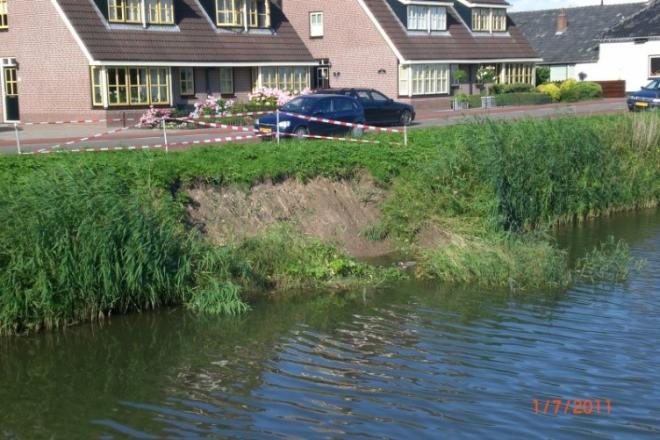
Erosion is another anomaly, which happens when water erodes the soil or other materials used in the construction of the levee. This can happen due to an excessive amount of surface water flowing along the levee (due to current or to high rainfall intensities) or due to wave action. Erosion can weaken the structure of the levee and make it more susceptible to failure. It can happen either on the inner or outer slope. Irregularities along the slope are weak points and locations where erosion rates may be higher than normal. For example, along houses, trees, changes in cover material, and other objects the grass cover may be weaker. Overtopping can also occur at these locations, causing higher flow velocities.
Backward erosion piping is a form of internal erosion and occurs underneath a levee at the interface between the sand aquifer an de cohesive top layer forming the basis of the levee.
Forms of expression associated with this damage pattern along the outer bank are:
- Erosion of the levee toe and/or the underwater bank;
- Damage to the grass cover due to erosion as a result of wave impacts and currents on the outer slope;
- Swirl formation under water;
- Collapse of animal burrows;
Important to note: the type and extent of damage are difficult to detect/estimate underwater.
Right: An example of erosion along the outer bank of a levee at the toe (source: Wiki Noodmaatregelen).
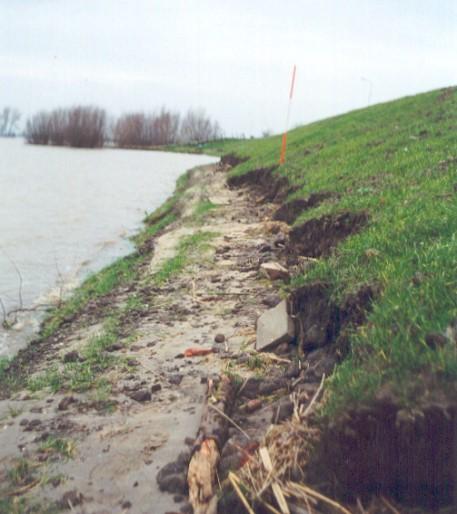
Overtopping is another phenomenon which can cause levee anomalies and damages if the inner slope does not have sufficient resistance against the water load. It happens when water flows over the top of the levee at high water levels. High water could occur due to heavy rainfall, snowmelt, or a failure of an upstream primary flood protection system, such as a dam. It illustrates that the levee is not high enough, either by insufficient maintenance, or by a water level higher than the design height of the levee crest.
Right: A levee with water flowing over the crest, illustrating the concept of overtopping (source: Wiki Noodmaatregelen)
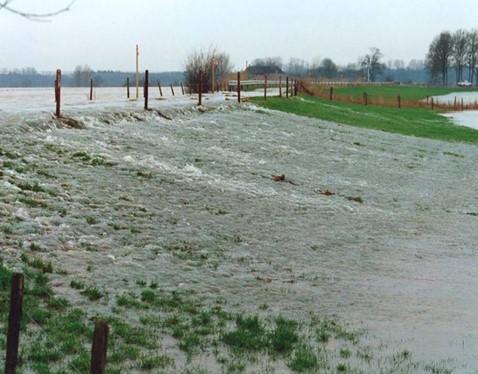
It's important to implement regular inspection, monitoring, and maintenance to detect these phenomena of overtopping or anomalies, so that preventive/corrective measures can be taken in time. The use of technology such as sensors, drones, and remote monitoring can help this process.
It's crucial to have an emergency response plan in place which can be implemented in case of failure. Such plans include clear communication procedures, evacuation plans, and emergency measures that can be implemented quickly. This can help to minimize the consequences of a failure and to protect lives and property.
3. FAILURE MECHANISMS
This chapter explores the various mechanisms by which levees can fail. This includes overtopping, where water flows over the top of the levee, piping, where water erodes the soil from beneath the levee foundation, and macro instability, where the levee is unable to support its weight. Understanding these failure mechanisms is crucial for determining the potential consequences of levee failure and for developing effective emergency measures. The right failure mechanism needs to be linked to the observed levee anomaly.
The figure below provides an overview of the main and most important failure mechanisms. Note that sometimes the levee anomaly is equal to the failure mechanism.
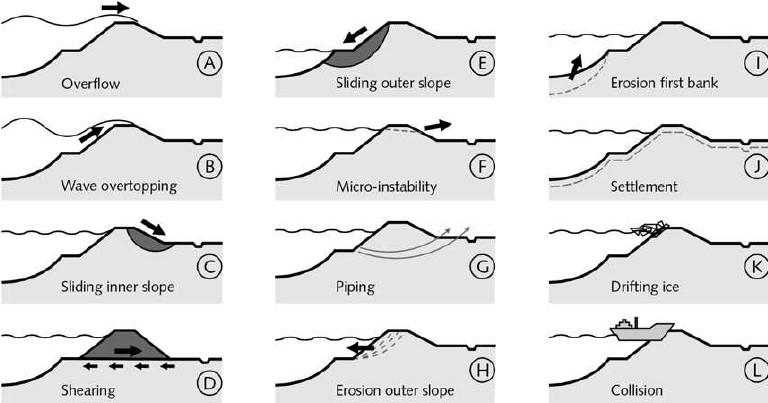
Above: Schematic overview of the main failure mechanisms of levees (source: Vrijling et al., 2011).
As described before, overtopping occurs when water flows over the top of the levee, it can happen due to heavy rainfall, snowmelt, or a failure of the primary flood protection system, such as a dam. Overtopping can cause inundation of the hinterland and can result in significant damage to buildings and infrastructure and can lead to the evacuation of communities.
Overflow is when the outside water level is higher than the levee crest height, then water start to flow over the crest. In the beginning it can be a thin layer of water with a low intensity, but this can cause many problems in the long run. Erosion of the inner slope in particular is a major risk.
If erosion of the levee cover (grass and clay) takes place, this can increase the concentration of the flow, which will speed up the erosion process. If the levee becomes saturated with water, sliding and outflow of the material in the levee core could take place. Eventually, a breach may occur in the levee and the hinterland will be flooded.
Piping is a failure mechanism that occurs when water erodes the soil from beneath the levee, i.e. the sand of the aquifer underneath a continuous cohesive top layer. It can happen due to seepage or other types of water infiltration into the aquifer. Piping can cause the levee to lose its stability and can lead to failure.
Right: A levee with piping: water flowing through a tunnel taking sand with it (source: Wiki Noodmaatregelen).
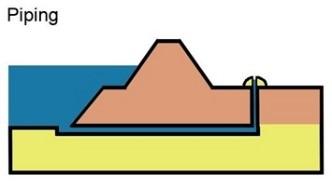
Instability is a failure mechanism that occurs when the levee is unable to support the weight of its structure. This can happen due to a lack of stability in the soil beneath the levee or due to an excessive amount of water flowing through the levee. Instability (macro or micro) can cause the levee to collapse and can lead to significant flooding.
Micro-instability is the erosion of the slope as a result of groundwater flow through a levee. It can occur both on the inner and outer slope of sand levees (with a slope steeper than 1:5) or levees with a sand core and clay cover if water flows through the levee (seepage) occurs during prolonged high water. This causes softening, the cover is lifted up and cracks and subsidence occur. This exposes the sand core and the material is washed out.
Other failure mechanisms that can occur include scouring, which is the erosion of soil around the base of the levee, and settlement, which is the sinking of the levee due to the compaction of the soil.
4. EMERGENCY MEASURES
This chapter explores the various emergency measures that can be taken to reduce the risk of levee failure and to minimize the consequences of failure. These measures include reinforcing levees, reinforcing the foundation of the levees (the base of the levee), and installing emergency flood barriers. Additionally, regular inspections, monitoring, and maintenance of levees can help to ensure the integrity of the structure and detect potential issues before they become critical.
Important to note: an emergency measure (actually an emergency measure that improves the strength or water resistance of the levee, contrary to measures that increase the load on the levee) is a measure that can be used when an (imminent) emergency is identified. The application of this measure takes place under high time (and political) pressure and often under bad weather conditions.
Five types of emergency measures are distinguished:
- Load-limiting
- Stability-enhancing
- Erosion-inhibiting
- Height-increasing
- Extra barrier
Load-limiting barriers have the goal to reduce the hydraulic load against the levee. Examples of measures are water level raising measures on the land side (e.g. by damming a ditch or raising polder water level), removing floating dirt, measures in case of ice threat, and promoting drainage of seepage water (e.g. puncturing the grass cover).
Reinforcing levees is an emergency measure that can be taken to increase the stability and strength of the levee. This can be realized by adding additional material, such as concrete or steel, to the structure.
Reinforcing foundations is an emergency measure that aims at enhancing the stability of the levee. This can be done by adding additional materials such as concrete or steel to the foundation of the levee. However, it can also imply that animal burrows are filled or that a damaged grass cover is repaired by applying protecting covers.
Installing extra emergency flood barriers is an emergency measure that can be taken to prevent water from flowing over the top of the levee.
The next section describes examples of suitable emergency response measure corresponding to the correct failure mechanism.
Failure mechanism: overflow and overtopping
Possible measure: sandbags
To fight overflow or overtopping, a suitable solution could be the use of sandbags.
The levee crest can temporarily be heightened, as to prevent overtopping and overflowing. For this, one or more layers of sandbags (15 to 60 cm), straw bales (up to 80 cm), big bags (up to 100 cm), tube or folding barriers can be used. If building up a barrier is considered, it should always be considered whether the measure will have an adverse effect on other failure mechanisms (e.g. sliding (macro-stability)). This also applies to the method of implementation the measure. Raising a levee with big bags, in combination with the equipment on the levee that places the big bags, leads to a considerable load and might result in a levee failure. Straw bales offer a solution for unstable dikes due to their relatively low weight. Straw bales should be anchored to wooden poles. Also, different barriers should be considered for preventing overtopping and overflow.
One of the most ‘traditional’ and common emergency measures is the use of sandbags. The photo below shows the use of sandbags to protect against rising water levels during a test. Under the step ‘Dimension & Execution’ a work instruction to use sandbags is provided.
Right: Sandbags being placed for training purposes, illustrating the concept of sandbags (source: Lex van der Hulst, 2022)
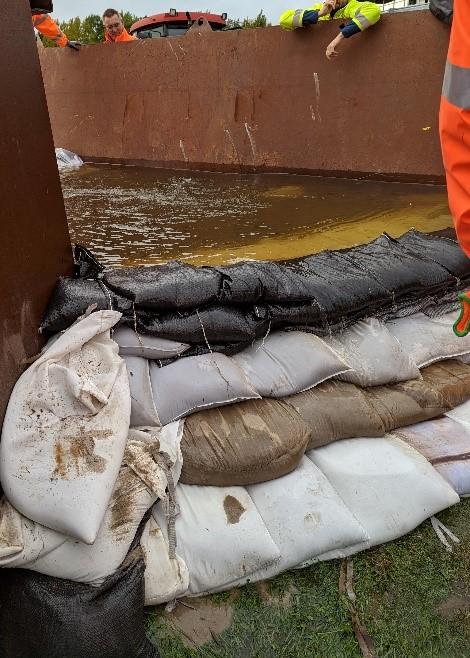
Failure mechanism: piping
Possible measure: ring levee
In the situation that a sand boil or piping is observed on the ground level, it can be decided to box them up. Then a ‘ring levee’ is constructed around the sand boil.
The sand-carrying material should be covered with a sand-tight, water-permeable cloth/geotextile. Then, the sandbags need to be placed in a closed ring on the geotextile (box up). The water level and therefore also the counter pressure are increased by the formwork. The cloth or geotextile ensures that sand from the subsoil is stopped.
It is not everyone’s preference to use a sand-tight cloth. Then, it could be decided to seal the sand boil with a cloth to keep an eye on the well and to see if the flow with sand stops. An outflow could also be included.
Note: the risk of incorrect construction of the ring levee (method of application and inspection) is often underestimated. If the ring levee is too high, the water pressure as a result of the counter-water pressure building up in the ring levee can build up so high that the top layer bursts at another location and a new sand-carrying layer is created. Secondly, in the case of trees, boxing is hardly possible.
Right: A ring levee as an emergency response measure to a sand boil/piping (source: Wiki Noodmaatregelen).
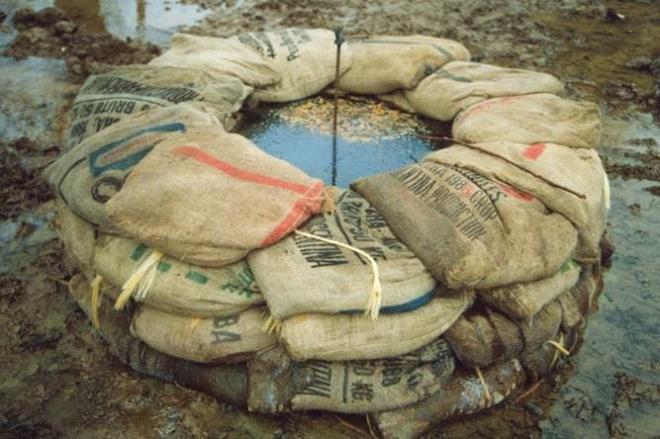
Failure mechanism: macro-stability inner bank
Possible measure: stability berm
Construction of a stability berm with soil/sand on the ground level at the inner toe to provide sufficient counter pressure.
The berm is of course installed in a short period of time. This is done with water-permeable material, such as sand, to ensure that any trapped water can flow out of the levee. Moreover, this material is more readily available and relatively easy to process, even in bad weather. The grass cover can be left intact in connection with the accessibility of the location for earthmoving equipment.
There is a risk of shearing or sinking of the berm itself, especially with soft subsoil. To reduce the chance of this happening, a sturdy geotextile or geogrid (water-permeable so that the drainage of seepage water is not hindered) can be applied to the ground level.
The berms should be applied from bottom to top, starting as far from the inside toe as possible, applied in thin layers.
If there is a good chance that the emergency measure will become a permanent measure, the grass lining on the inner slope (where the berm connects to the levee) should be removed and preferably enclosed. The thickness and width of the berm depend on the shape of the dike, the type of load and the shape (and size) of the sliding surface and can best be determined on the basis of a few indicative stability calculations. If there are adjoining areas near the toe of the flood defence, it must be considered whether reinforcement is necessary here, and damage to the adjoining areas must be taken into account.
The transport route for the required materials must be found at polder level. It is better not to supply the material from the crest because the extra load reduces the stability of the levee.
As a measure for macro-instability: a stability berm is most effective when most of the extra load (material) is placed in the passive part of the shear circle. This is especially important if uplift or cracking is involved. A wide-flat berm is then most suitable. An example of a wide-flat berm is shown in the picture.
For the failure mechanism micro-instability: micro-instability occurs at the inner slope of a dike. Therefore, the measure (in this case a support berm) is most effective if it is applied as much as possible against the slope. The sand from the verge acts as a filter, so that sand from the dike core remains. If the risk of macro-instability is not so great, the berm can be relatively narrow and higher (see photo). A slope softening can also be applied. For this, see measure 'Reduce the inner slope'.
Lastly, if piping occurs: if a measure against piping is required over larger surfaces, a piping berm can be installed.
A stability berm can basically also be made with sandbags. This may only be an option for relatively small levees and if the problem area is limited in the longitudinal direction of the levee. After all, a lot of sandbags are quickly needed.
Right: Levee stability berm as a measure for macro-instability (source: Wiki Noodmaatregelen)
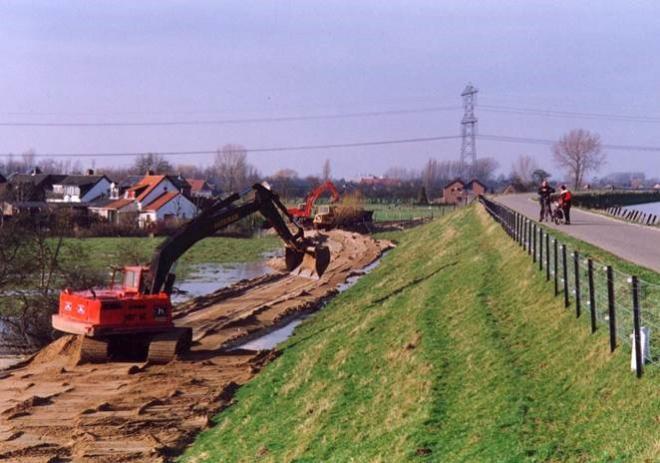
Levee stability berm as a measure for micro-instability (source: Wiki Noodmaatregelen)
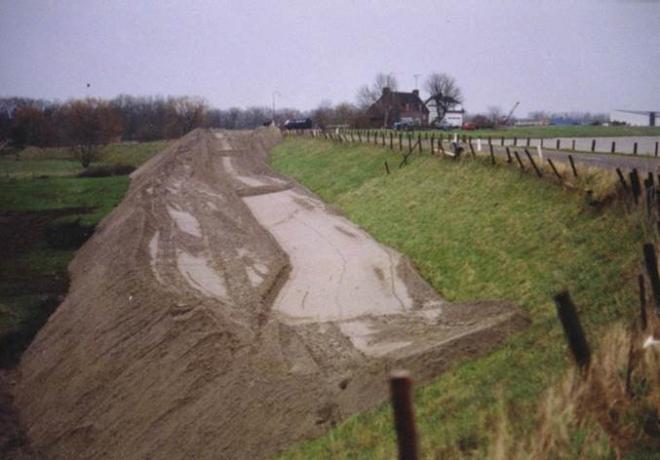
Failure mechanism: erosion outer slope
Possible measure: levee protecting cover
In order to prevent erosion on the inner bank by, for instance, overtopping or overflowing water, applying a protecting layer with geotextile is an effective measure. Flooding is the only situation where a geotextile may be applied to the inside of the levee: if the flooding cannot be prevented, an attempt must in any case be made to reduce the risk of erosion of the levee surface. Geotextiles that can be laid on the dike are suitable for this purpose. These should be supported with weights, which should be lowered as far as possible on the outside of the dike. The end of the film can be attached with steel pipes. The weight of the overflowing water presses the geotextile against the levee.
However, keep in mind that a protecting layer is not always the right measure. It makes water trapped in the levee difficult to drain and this measure is contrary to the old flood defence principle that a levee should be the least permeable at the outer bank and that the permeability should increase towards the inner slope. When choosing between water-permeable or water-tight fabric, careful consideration should be given to which functional requirements are set for the measure, given the expected failure mechanism. If it follows from this that water tightness is not required, then preferably use a soil-tight, water-permeable cloth. More information can be found in the work instruction on levee protecting covers, in the ‘dimension and execution’ tab.
Right: Levee protection cover to protect against erosion of the levee (source: Wiki Noodmaatregelen)

5. DIMENSION & EXECUTION
This chapter focuses on the correct and effective execution of emergency measures of flood defences. This includes the organization and coordination of emergency response teams, the deployment of equipment and resources, and the communication and dissemination of information to affected communities. It should be noted that it is essential to train and prepare emergency response teams and communities in advance, as to ensure that they are ready to take the right action in case of a flood emergency. Regular training and exercises can help to test and refine emergency response plans.
The organization and coordination of emergency response teams are crucial during a flood emergency. Hereby, it is important to have a clear chain of command, and a well-defined plan of action. The deployment of equipment and resources should be executed in an efficient, timely and safe manner.
Right: Emergency responders or community members during a drill or exercise, as to illustrate the concept of training and preparation (source: Polder2C’s).
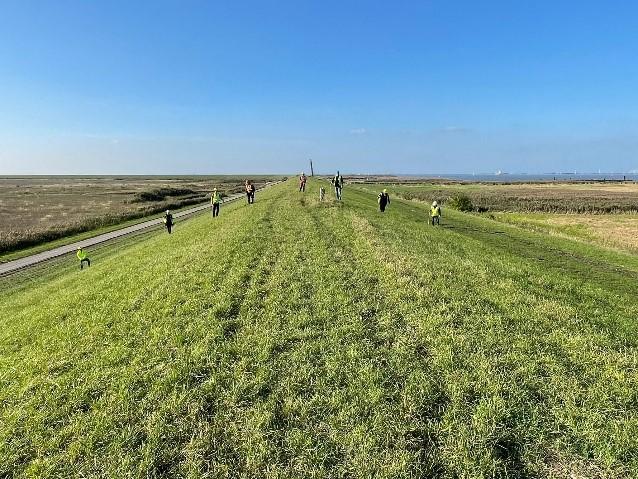
The following two work instructions/guides have been developed and translated from Dutch to English:
- Instruction to use sandbags background
- Work instructions how to use sandbags
- Instruction for the application of levee-protecting coverings
It should be mentioned that it is not possible to directly adopt this work instruction since every location is different. However, it does provide guidance in the development of a work instruction.
Inspection Team Averting Floods (ITAF) is a pool of experienced senior flood experts, that can provide advice regarding flood defences and ensuring effective and efficient emergency response. Team members can be deployed inside the EU as well as worldwide. If required back office support in the Netherlands can be provided, make use of independent ICT. We are keen to join forces, both to help each other during flood events as well as help to learn from each other in general.
Are you interested to know more about ITAF, please get in touch with us. Please approach:
- Mr. Wijnand Evers: wijnandevers@wdodelta.nl, +31 (0)650235269
- Mr. Anco van den Heuvel: Anco.vanden.heuvel@rws.nl, +31 (0)64674227
- Mr. Frank Janssen: frankjansen@wdodelta.nl, +31 (0)627031962
6. EMERGENCY MEASURE EXAMPLES FROM POLDER2C'S
The chapter aims to provide a brief overview of possible innovations, examples, and research questions regarding emergency response measures in an international setting. The European Interreg project Polder2C’s aims to test in an international environment current and innovative techniques, processes, methods and products for practical validation. A small selection is explained here.
An emerging type of levee anomaly that is studied more intensively, particularly in the Polder2C’s project, are the presence of animal burrows. These are formed by animals that dig burrows and therefore damage the grass cover and the core of the levee. Also, the inner and outer banks can be damaged by the animals. A damaged grass cover is less resistant and, consequently, more vulnerable to erosion. Examples of animals that dig holes and tunnels in levees are beavers, badgers, rabbits, moles, mice, and muskrats. The clay layer can be damaged as well. Consequently, holes are dug through the sand core of the levee which forms a higher risk of levee instability. Of course, the structures of levees are different in every country, the impact of the animal burrows could therefore have different impacts.
The excavated burrows must be blocked. However, this is not the only adequate solution. The existing burrows result in a permanent weakening of the levee. Internal erosion will slowly reduce the strength of the levee.
Innovative ideas have been developed and tested, such as: the application of smoke to detect interconnectedness of adjacent burrows and electric resistivity tomography measurement to monitor how the geometry of burrows changes during overflow generator tests (Polder2C’s).
It must be noted that the topic of animal burrows is emerging and the consequence and solutions have not been studied enough. There is not one sufficient solution or practice. More research is needed.
Right: Excavated animal burrows, displayed by using cement (source: Polder2C’s)
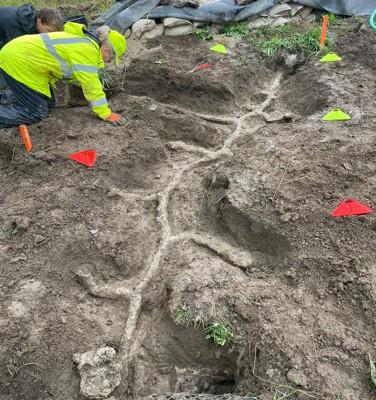
During Polder2C’s, overflow tests have been conducted in which emergency response measures have been tested. The overflow generator is a system which could simulate the process of overflow. Water uninterruptedly flows down the inner slope, typically via a demarcated test strip. The variable which can be change are the water level, water velocity and pump discharge and at the same time measurement devices are monitoring the tests and state of the levee. An experiment normally takes some hours or stops when the created damage threatens the levee stability.
For instance, the application of rock bags, the use of standard clay, clay with a seed mix for vegetation, a reinforced turf mat and a light translucent geotextile. The goal was to study how well can they endure continuous water overflow and how do they compare to each other?
Another innovate idea to share knowledge on emergency response measure is The Levee Challenge. This is a unique event where contenders test their skills and knowledge by creating innovative emergency response measures and repairs on a real levee. The measures have as the objective to be able to withstand wave overtopping. In 2022, four teams participated in the Hedwige-Prosperpolder: one student team and three professional teams attempted to become the winner of the Levee Challenge.
More systems and ideas were tested during the Polder2C’s project. Often with the objectives to practice using these several types of mobile barriers and to study how efficient and effective the systems are. The findings are valuable to gain knowledge on the emergency response measures and to learn from the different (international) partners. More information can be found on the Polder2C’s website https://polder2cs.eu/.
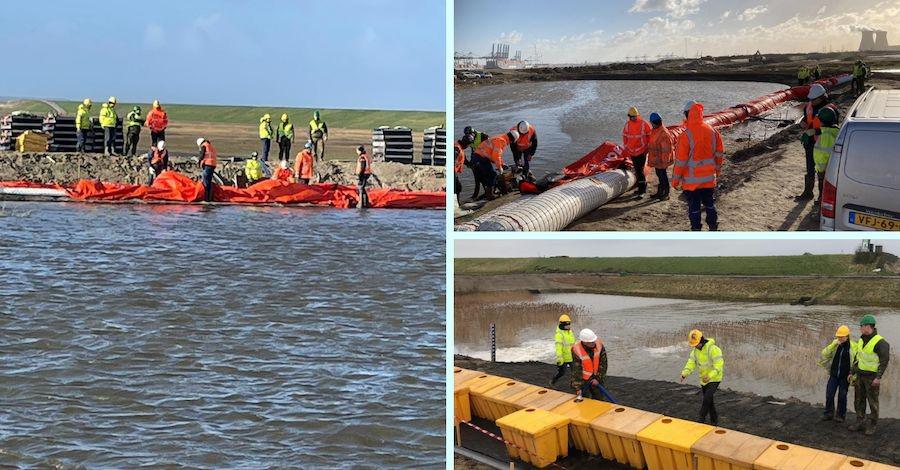
Above: The different types of emergency measures tested in the Living Lab Hedwige-Prosperpolder (source: Polder2C’s).

 English resume
English resume